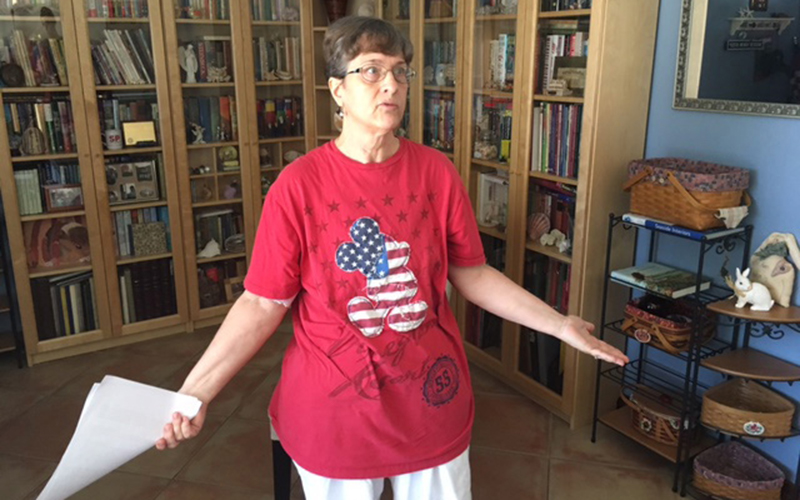
TEMPE – Chronic pain grips Lauri Nickel every day, day after day.
“It’s like someone has got a claw that is made out of stainless steel and the points are sharp and it’s gripped around your spine,” Nickel said. “Then attached to it is a chain and a ten pound weight. That’s just what the back pain feels like. There’s also the fire that goes down your leg and the burning in your feet.”
Relief, she says, comes from prescription opioids.
Nickel, who suffers from a ruptured disc and nerve pain throughout her body, said as regulations tighten on opioids in an effort to mitigate a nationwide epidemic of abuse, chronic pain patients who use opioids responsibly get “tossed to the curb.”
A new 400-page report this week by leading doctors across the country called on the FDA to develop new regulations for opioid prescriptions, balancing the need to treat pain properly and avoid opioid abuse.
The report’s researchers said doctors, pharmacists and others in the medical profession need to work to halt the rising levels of opioid abuse, even though the medications are necessary for people with intense pain. They also recommended doctors receive training in pain management.

Lauri Nickel takes prescription opioids, visits a chiropractor and gets ketamine infusions to manage her pain. (Photo by Lauren Marshall/Cronkite News).
Treatment tool box
Nickel ruptured a disc in 1989. Five years later, while receiving an epidural injection, she said a doctor hit a nerve root, causing permanent damage and pain. Add in a pain disorder, arachnoiditis, and even basic movement is painful.
“Taking away pain medication from people who need them will not reduce addiction at all,” Nickel said. “Addicts will find something, anything, to substitute.”
Nickel, who relies on an oxycodone prescription, chiropractor and ketamine infusions to manage her pain, said regulating opioids without considering chronic pain sufferers does not address treatment for those who abuse. Instead it punishes those who need opioids for their health.
“It is one of the tools in a pain patient’s tool box, and the more tools we have in our toolbox, the better we can manage our pain,” she said.
‘Culture change’
The FDA commissioned the report, which mirrors concerns across the country about a crisis that kills 90 people nationwide a day. Last year 790 people in Arizona died from an opioid overdose, according to the Arizona Department of Health Services.
Dr. Mark Schumacher, a San Francisco doctor who contributed to the researchers’ report, said it’s time for a “culture change” among medical professionals.
“At the heart of the committee’s work is the sobering fact that the majority of deaths attributed to opioids are initiated through a prescription,” he said.
Dr. Daniel Brooks of Banner Health said some patients have unrealistic expectations that they can age or have a major surgery with no pain.
“The normal aging process is to become weak and have some aches and pains,” Brooks said.
Brooks said there needs to be a balance in treating those who are truly in pain and educating patients who expect to live with zero pain their whole lives.
“I think some folks truly do have significant amounts of pain, either in intensity or duration, and that they feel that they’ve lost control,” Brooks said. “They’re very nervous or anxious about being in pain, and we have to clearly respect those needs and address them.”
In the report, researchers called on insurance companies, physicians, pharmacists and therapists to take responsibility for their role in opioid abuse.
Arizona battleground
Arizona’s efforts to battle opioid abuse include limiting prescriptions of painkillers to seven days to those on Medicaid or state aid and requiring a doctor’s visit before refills are allowed. Gov. Doug Ducey declared deaths caused by opioids a statewide health emergency in early June.
The Department of Health Services now requires health providers to report opioid prescriptions and overdoses within 24 hours.
Nickel said the requirement to go to the doctor every seven days takes a toll on patients’ health and wallets.
“The government is interfering with my relationship with my doctor,” Nickel said.
Managing pain
The report, from the National Academies of Sciences, Engineering and Medicine, shows pain management has been difficult for doctors to navigate. Research is lacking and education for healthcare providers in treating pain is “inadequate and underfunded.”
Brooks said physicians find it difficult to treat because, aside from conditions where scans can show visible injury or nerve damage, there are no tests for pain.
“The only way we can measure it is by listening to the patient or asking them if it is getting better or worse,” Brooks said.
Still, he said, only a small minority of patients need opioids.
People in the U.S. expect to treat their pain problems only with painkillers, Brooks said, adding that many of his patients are unwilling to do tasks like lose weight or exercise everyday to reduce pain.
“It involves more time and dedication by both the physician and patient,” Brooks said.
Alternative pain treatments like acupuncture, counseling, anti-inflammatory medication can be effective and more appropriate to treat pain for certain conditions, Brooks said.
But few insurance companies cover alternative pain treatments, Schumacher said.
Doctors also may over prescribe opioids because it is simpler and appeases patients.
“We need to be better shepherds of these medications and see how dangerous they can be,” Brooks said.
Nickel visited several doctors before she found one who respected her and her pain.
“Pain management is not one size fits all,” Nickel said.
